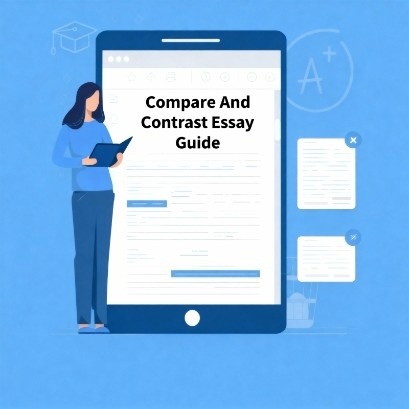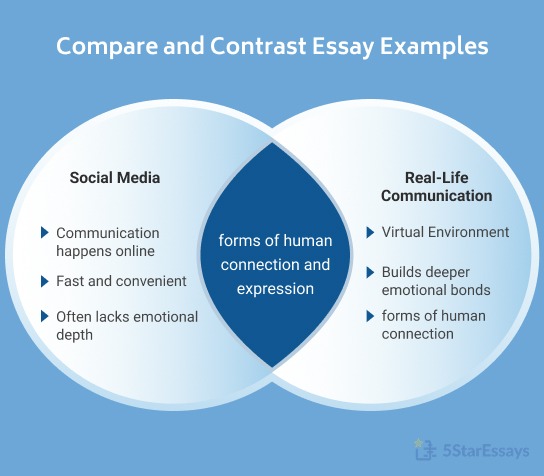Learning how to write a compare and contrast essay transforms you from a passive observer into an analytical thinker. Whether comparing novels for English class, historical events for history, or scientific theories for science, this guide provides the step-by-step process to craft compelling comparison essays that earn top grades.
Compare and contrast essays challenge students because they require juggling multiple subjects while maintaining clear organization and analytical depth. You must understand both subjects thoroughly, identify meaningful comparison points, organize information logically, and articulate relationships clearly, avoiding the common pitfall of listing similarities and differences without analysis.
This guide covers every stage:
- Choosing subjects.
- Developing thesis statements.
- Structuring your essay.
- Writing analytical paragraphs,
- Revising systematically.
By the end, you'll understand when to use point-by-point versus block organization, how to craft transitions, how to balance analysis, and how to synthesize insights.
For a complete overview of the entire comparison process, explore our comprehensive compare and contrast essay guide that situates these writing techniques within the broader essay workflow.
PART 1: PRE-WRITING ESSENTIALS
Choose Subjects Strategically
Subject selection determines essay success before you write anything. Follow these criteria:
Same Category Requirement: Both subjects must belong to the same category, such as two novels, two theories, or two historical figures. Never compare unrelated items like "cats and capitalism."
Meaningful Connection: Look for subjects with significant similarities AND notable differences. Too similar subjects lack differences to analyze. Too different subjects lack common ground.
Available Information: Ensure sufficient credible sources about both subjects. Comparing a well-documented figure with an obscure one creates an imbalanced analysis.
Personal Interest: Choose subjects that genuinely interest you. Your engagement shows in writing quality.
If you're struggling to find the right subjects, browse our curated collection of compare and contrast essay topics organized by subject area and difficulty level.
Research and Brainstorm
Before outlining, gather comprehensive information about both subjects. Create a Venn diagram, two overlapping circles, to organize:
- Left circle: Characteristics unique to Subject A.
- Right circle: Characteristics unique to Subject B.
- Center overlap: Shared characteristics.
This visual organization reveals whether you have balanced material and helps identify 3-5 meaningful comparison criteria.
Strong criteria reveal insights, not obvious facts:
- Weak: "Both novels are written in English."
- Strong: "Narrative perspective shapes reader sympathy differently."
PART 2: DEVELOP YOUR THESIS
Your thesis is your essay's most important sentence. It must argue something meaningful about the relationship between subjects.
Three Essential Components:
- Identify both subjects clearly
- Indicate your approach (compare, contrast, or both)
- Preview your argument or conclusion
Weak Thesis Examples:
"This essay will compare and contrast cats and dogs."
"Cats and dogs are different pets."
"There are several similarities and differences."
Strong Thesis Examples: "While both cats and dogs provide companionship, dogs require significantly more owner engagement through training and exercise, making cats the more practical choice for busy professionals seeking low-maintenance pet ownership."
"Although renewable and fossil fuel energy sources both power modern society, their environmental impacts, long-term sustainability, and economic considerations differ dramatically, with renewable energy emerging as necessary for humanity's future despite higher initial costs."
Strong theses argue positions, not just announce topics. They take a stance based on the comparison analysis.
Still Struggling With That Essay?
Submit With Total Confidence
No AI ever. Just real academics who know what graders want
PART 3: CHOOSE YOUR STRUCTURE
Every compare and contrast essay uses one of two organizational methods. Choose based on your subjects and assignment.
Point-by-Point Method
Structure: Each body paragraph addresses one criterion, discussing both subjects within that paragraph.
Pattern:
- Introduction with thesis.
- Criterion A: Subject 1, then Subject 2.
- Criterion B: Subject 1, then Subject 2.
- Criterion C: Subject 1, then Subject 2.
- Conclusion
Best for:
- Subjects with many similarities and differences.
- Direct comparison that illuminates relationships.
- Complex subjects requiring detailed analysis.
- Longer essays (1,500+ words).
Example: Comparing smartphones; discuss camera quality for both phones, then battery life for both, then interface for both.
Block Method
Structure: Discuss all aspects of Subject A completely, then discuss all aspects of Subject B using the same criteria in the same order.
Pattern:
- Introduction with thesis.
- Subject A: All criteria (A, B, C).
- Subject B: All criteria (A, B, C).
- Conclusion with explicit comparison
Best for:
- Quite different subjects needing independent explanation.
- Shorter essays (under 1,000 words).
- Subjects requiring contextual background.
- Arguing one subject's clear superiority.
For detailed templates showing exactly how to structure both methods with filled examples, access our professional Compare and Contrast essay outline templates with step-by-step formatting guides.
PART 4: WRITE YOUR ESSAY
Craft a Compelling Introduction
Your introduction must hook attention, provide context, and present your thesis.
Hook Strategies:
- Surprising statistic: "In 2024, renewable energy generated 30% of global electricity, triple the percentage from fifteen years earlier."
- Provocative question: "Would you rather read a physical book or an e-book?"
- Brief scenario: "When Professor Martinez assigns comparison essays, half her students relax while the other half tense."
Provide Context: Offer necessary background about your subjects and why comparing them matters.
Present Thesis: State your thesis clearly as the final sentence of your introduction.
Write Analytical Body Paragraphs
Each body paragraph should follow this structure:
- Topic Sentence: Introduce the comparison criterion.
- Subject A Analysis: Detailed examination with specific evidence.
- Transition Signal: "In contrast," "Similarly," "Whereas."
- Subject B Analysis: Parallel examination with specific evidence.
- Explicit Comparison: State how subjects relate to this criterion.
- Significance Analysis: Explain WHY this matters.
- Transition to Next: Bridge to the following paragraph
Essential Elements:
- Use transition words extensively: "similarly," "in contrast," "however," "likewise," "conversely".
- Provide specific evidence: Examples, quotations, statistics, expert opinions.
- Analyze, don't just describe: Explain significance, not just features.
- Maintain balance: Equal attention to both subjects
To see how expert writers structure comparison paragraphs with effective transitions and evidence integration, study our collection of compare and contrast essay examples with highlighted techniques across all education levels.
Write a Synthesis Conclusion
Effective conclusions synthesize analysis into meaningful insights beyond mere summary.
Conclusion Components:
- Restate Thesis: Rephrase your argument (never copy-paste).
- Synthesize Key Points: Weave comparisons into a cohesive understanding, show how they connect, don't list separately.
- Broader Implications: Explain what your comparison reveals about larger principles or debates.
- Final Insight: End with a thought-provoking observation or future direction
Avoid:
- Introducing new comparison points.
- Simply listing what you discussed.
- Apologizing for limitations.
- Generic phrases like "In conclusion."
Still Struggling With That Essay?
Submit With Total Confidence
No AI ever. Just real academics who know what graders want
PART 5: REVISION STRATEGIES
Professional writing emerges through revision, not first drafts. Use this systematic approach:
Content Revision (First Pass):
- Does every paragraph support your thesis?
- Have you maintained a balanced analysis?
- Are comparison points meaningful rather than obvious?
- Have you provided sufficient evidence?
- Does analysis explain WHY differences matter?
Organization Revision (Second Pass):
- Do paragraphs follow logical order?
- Have you used effective transitions?
- Does your structure work effectively?
- Can readers easily follow your comparison?
Sentence-Level Revision (Third Pass):
- Eliminate wordiness and redundancy.
- Vary sentence structure for readability.
- Strengthen weak verbs and vague language.
- Ensure academic tone throughout.
Proofreading (Final Pass):
- Check spelling, grammar, punctuation.
- Verify proper citation format.
- Confirm formatting consistency.
- Read aloud to catch awkward phrasing.
COMMON MISTAKES TO AVOID
1. Comparing Unrelated Subjects: Never compare items from different categories. "Hamlet versus quantum physics" produces meaningless analysis.
2. Listing Without Analyzing: Simply stating "Subject A does X while Subject B does Y" without explaining the significance produces shallow analysis. Always explain WHY differences or similarities matter.
3. Imbalanced Analysis: Spending three paragraphs on Subject A but one on Subject B undermines comparison. Maintain approximately equal coverage.
4. Weak Thesis Statements: "This essay will compare X and Y" isn't a thesis; it's an announcement. Your thesis must argue something meaningful.
5. Missing Transitions Without clear transitions, readers can't follow your comparison. Use transition words every 2-3 sentences.
6. Obvious Comparisons "Both novels are written in English" wastes space. Focus on meaningful, non-obvious similarities and differences.
ADVANCED TECHNIQUES
Address the "So What?" Question
Never assume readers understand why your comparison matters. Explicitly explain: "This difference matters because it reveals fundamentally different assumptions about X."
Identify Underlying Causes
Move beyond describing differences to exploring why subjects differ: "These contrasting approaches stem from different cultural contexts and historical experiences."
Challenge Common Assumptions
Use comparison to expose flawed thinking: "The popular belief that X is superior reflects mistaken assumptions that comparison reveals as incorrect."
DOWNLOADABLE RESOURCES
Writing Templates
Planning Tools
CONCLUSION
You now have a complete roadmap for writing exceptional compare and contrast essays. From choosing subjects through systematic revision, you understand every stage and the techniques separating competent essays from outstanding ones.
Key principles to remember:
- Choose subjects offering analytical opportunities.
- Develop thesis statements that argue rather than announce.
- Select organizational methods suited to your subjects.
- Maintain balanced analysis with equal attention and evidence.
- Use transitions extensively.
- Analyze WHY similarities or differences matter rather than just describing them.
- Synthesize insights beyond mere summary.
As you apply these techniques, remember that excellence emerges through practice and revision. Use our complete compare and contrast essay guide as your reference, study compare and contrast examples to see principles in action, utilize compare and contrast essay outline templates, and explore compare and contrast essay topics collections for inspiration.
Most importantly, embrace comparison thinking as a valuable intellectual tool. Master this essay type, and you've mastered fundamental analytical thinking that serves you across all academic and professional contexts.
Still Not Sure? Try Us Free.
Get your first essay — up to 2 pages — at zero cost. Experience the difference before you commit.
- 100% original, human-written content
- Matched with an expert in your subject
- On-time delivery guaranteed
- Unlimited revisions included
No AI. No payment. No pressure.
Try It Risk-Free







